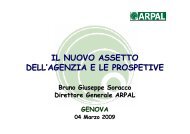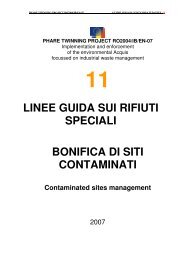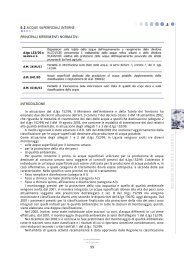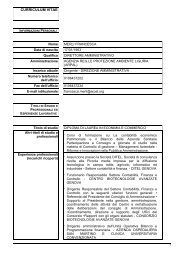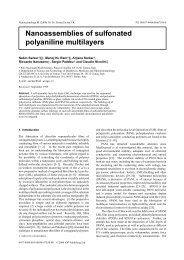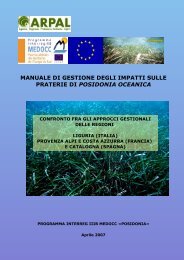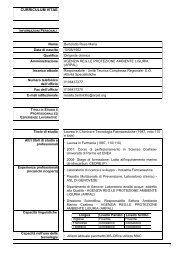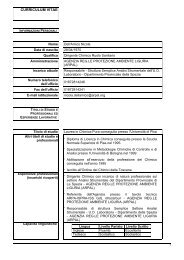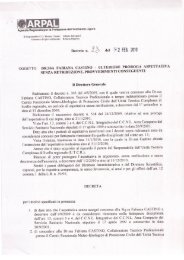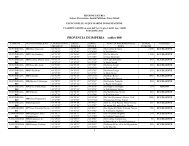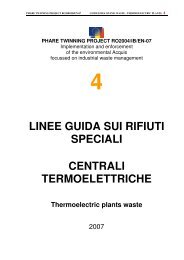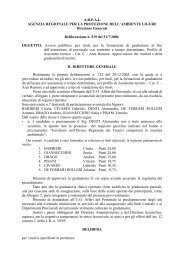Polycyclic aromatic hydrocarbons in surficial coastal ... - ARPAL
Polycyclic aromatic hydrocarbons in surficial coastal ... - ARPAL
Polycyclic aromatic hydrocarbons in surficial coastal ... - ARPAL
You also want an ePaper? Increase the reach of your titles
YUMPU automatically turns print PDFs into web optimized ePapers that Google loves.
Basel<strong>in</strong>e / Mar<strong>in</strong>e Pollution Bullet<strong>in</strong> 46 (2003) 903–917 907<strong>Polycyclic</strong> <strong>aromatic</strong> <strong>hydrocarbons</strong> <strong>in</strong> <strong>surficial</strong> <strong>coastal</strong> sedimentsof the Ligurian SeaR.M. Bertolotto a , F. Ghioni b , M. Frignani c, *, D. Alvarado-Aguilar c , L.G. Bellucci c ,C. Cuneo a , M.R. Picca a , E. Gollo ba Agenzia Regionale Protezione Ambiente Ligure (<strong>ARPAL</strong>), Direzione Scientifica, P.za Vittoria 15, 16121 Genova, Italyb Agenzia Regionale Protezione Ambiente Ligure (<strong>ARPAL</strong>), Dipartimento di Genova, V. Montesano 5, 16121 Genova, Italyc Istituto di Scienze Mar<strong>in</strong>e, Sezione di Geologia Mar<strong>in</strong>a, CNR, Via Gobetti 101, 40129 Bologna, ItalyKeywords: <strong>Polycyclic</strong> <strong>aromatic</strong> <strong>hydrocarbons</strong>; Sediments; Sources; Ligurian Sea<strong>Polycyclic</strong> <strong>aromatic</strong> <strong>hydrocarbons</strong> (PAHs) are a classof ubiquitous organic compounds with two to sevencondensed <strong>aromatic</strong> r<strong>in</strong>gs. Common characteristics ofPAHs are very low solubility <strong>in</strong> water, good aff<strong>in</strong>ity formany organic solvents, low volatility, except for the verylow molecular weight congeners, and a tendency to adsorbonto sediment particles. Sixteen PAHs are consideredby the US EPA as priority micropollutantsbecause of their carc<strong>in</strong>ogenic and mutagenic properties(Arcos and Argus, 1975).PAHs have numerous sources, both natural and anthropogenic.They are naturally present <strong>in</strong> tar, bitumenand oil. Furthermore, certa<strong>in</strong> compounds such as peryleneand retene are thought to be produced diagenetically(Wakeham et al., 1980b). Anthropogenic sources<strong>in</strong>clude combustion of fossil fuels, waste <strong>in</strong>c<strong>in</strong>erationand production of coke, carbon black, coal tar pitch,asphalt and petroleum crack<strong>in</strong>g (Hallet and Brecher,1984; and references there<strong>in</strong>; McCready et al., 2000).Spillage of fossil fuels is another common anthropogenicsource of PAHs. Pyrolytic and petrogenic sources areknown to generate substantially different PAH assemblages.In general, combustion products are dom<strong>in</strong>atedby relatively high molecular weight (HMW) compoundswith four condensed r<strong>in</strong>gs or more. In contrast, mono-,bi- and tricyclic <strong>aromatic</strong> compounds (LMW) are mostabundant <strong>in</strong> fossil fuels (Prahl and Carpenter, 1983) andthese PAH mixtures conta<strong>in</strong> high levels of alkylatedcongeners. Much work has been dedicated to the assessmentof PAH contam<strong>in</strong>ation levels coupled to theidentification of the sources through study of sediments(e.g. Youngblood and Blumer, 1975; Wakeham et al.,1980a; Canton and Grimalt, 1992; Soclo et al., 2000;McCready et al., 2000). The purpose of this study was todeterm<strong>in</strong>e distribution, degree of contam<strong>in</strong>ation, sourcesand potential toxicological significance of PAHs* Correspond<strong>in</strong>g author. Tel.: +39-51-6398906; fax: +39-51-6398940.E-mail address: frignani@igm.bo.cnr.it (M. Frignani).<strong>in</strong> <strong>surficial</strong> sediments along the coast of the LigurianSea.The Ligurian Sea belongs to the northern part of thewestern Mediterranean. The <strong>coastal</strong> morphology of theLiguria Region is variable, and frequently cliffs dropsheer to the sea. The limited width of the <strong>coastal</strong> zonedeterm<strong>in</strong>es a gather<strong>in</strong>g of the urban areas with a consequentconcentration of both civil and <strong>in</strong>dustrial presence<strong>in</strong> a narrow but highly populated territory. In particularGenova, but also other cities, have a long history of <strong>in</strong>dustrialand harbour activities, whereas long tracts of thecoast are dedicated to tourism. The circulation of theLigurian Sea is dom<strong>in</strong>ated by surface and <strong>in</strong>termediatecurrents that follow a cyclonic circulation. However,local circulation is responsible for the dispersion ofsediment material along the coast, and these longshorecurrents often cause an eastward oriented transport.Sampl<strong>in</strong>g was carried out <strong>in</strong> 1998 at 75 stations <strong>in</strong> the25 localities shown <strong>in</strong> Fig. 1. Three sediment sampleswere collected along transects at 500, 700 and 1000 mfrom the shorel<strong>in</strong>e us<strong>in</strong>g a Van Veen grab, whose penetrationwas typically 10–20 cm. The topmost sediment(2 cm) was carefully removed with a sta<strong>in</strong>less steel spoonand transferred to glass screw cap jars with alum<strong>in</strong>iumfoil lid l<strong>in</strong>ers. The sediment samples were stored at )18°C before analysis.PAHs determ<strong>in</strong>ed <strong>in</strong>cluded naphthalene (Na),1-methylnaphthalene (1mNa), 2-methylnaphthalene(2mNa), fluorene (Fl), phenanthrene (Phe), anthracene(An), fluoranthene (Flt), pyrene (Py), chrysene (Ch),benzo(a)anthracene (BaA), benzo(b)fluoranthene (BbF),benzo(k)fluoranthene (BkF), benzo(a)pyrene (BaP),<strong>in</strong>deno(1,2,3-cd)pyrene (IPy), dibenzo(a,h)anthracene(DBA), and benzo(g,h,i)perylene (Per). Results are thuspresented for 14 US EPA priority PAH congeners (all butacenaphthene and acenaphthylene) together with 1- and2-methylnaphthalene. Analyses were carried us<strong>in</strong>g a fluorimetricmethod modified from Kootstra et al. (1995).Approximately 15 g of homogenised wet sedimentwas extracted twice with 20 ml of acetone <strong>in</strong> an
Table 1Quality of the analytical resultsPAH Precision (%) Accuracy a (%) Accuracy b (%) Recovery (%) Detection limit (lg/kg)Naphthalene 6.2 91.2 – 87 8.8 0.16Fluorene 7.4 90.5 – 95.7 2.7 0.20Phenanthrene 6.2 82.7 – 80.4 5.9 0.14Anthracene 4.6 91.0 – 85.2 4.7 0.02Fluoranthene 3.1 85.5 – 82.9 8.1 0.60Pyrene 2.5 85.0 83.3 80.1 10.1 0.20Chrysene 4.9 96.1 – 94.4 2.8 0.10Benzo(a)anthracene 6.9 95.0 79.2 92.1 2.5 0.10Benzo(b)fluoranthene 5.5 96.1 96.9 93.7 4.7 0.18Benzo(k)fluoranthene 3.6 97.1 91.7 96.7 9.6 0.10Benzo(a)pyrene 5.3 95.8 94.8 92.4 2.5 0.12Dibenzo(a,h)anthracene 5.7 95.9 – 87.3 1.9 0.20Benzo(g,h,i)perylene 0.6 84.4 – 81.1 4.1 0.30Indeno(1,2,3-cd)pyrene 11.8 93.5 83.3 98 9.7 2.0a From additions of know amounts of standards.b From the certified material BCR CRM 535 (Freshwater harbour sediment).Basel<strong>in</strong>e / Mar<strong>in</strong>e Pollution Bullet<strong>in</strong> 46 (2003) 903–917 909Genova us<strong>in</strong>g sieves to separate the f<strong>in</strong>es (silt pus clay)from the coarser sediment. A Coulter Counter II wasused to quantify the f<strong>in</strong>e sediment fractions.Fig. 1 shows that surface sediments conta<strong>in</strong> a widerange of total PAH concentrations, from very low (
910 Basel<strong>in</strong>e / Mar<strong>in</strong>e Pollution Bullet<strong>in</strong> 46 (2003) 903–917Table 2Analytical results for the 12 sites with the highest PAH concentrations and percent content of f<strong>in</strong>e particlesF<strong>in</strong>es(%)TotalPAH(lg/kg)Per(lg/kg)DBA(lg/kg)IPy(lg/kg)BaP(lg/kg)BkF(lg/kg)BbF(lg/kg)BaA(lg/kg)Ch(lg/kg)Py(lg/kg)Flt(lg/kg)An(lg/kg)Phe(lg/kg)Fl(lg/kg)2mNa(lg/kg)1mNa(lg/kg)Na(lg/kg)Prov<strong>in</strong>ce Transect Distancefrom thecoast(m)Savona F<strong>in</strong>ale Ligure 1000 6.82 2.27 11.8 21.2 1427 465 3244 2931 2128 2042 3515



